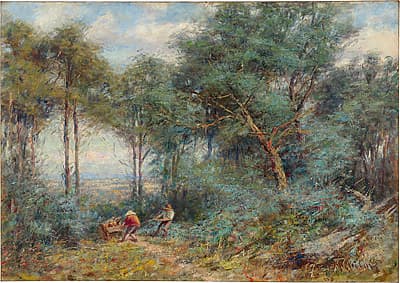Frederick
MCCUBBIN
Australia
1855
–
1917
Hauling rails for a fence, Mount Macedon
[(Mt. Macedon landscape with two men hauling a wood-cart)]
1910
oil on canvas
signed [and dated?] l.r., brown oil "F. McCUBBIN [illeg.]"
71.5 (h)
x 101.5 (w)
cm
Purchased 1964
National Gallery of Australia, Canberra
NGA 1964.46
We know the day, and almost the hour, in the fresh early morning when McCubbin discovered the subject of this picture, because he wrote an excited postscript about this work, and included a thumbnail sketch, in a letter to Tom Roberts. It was 19 January 1910—summertime. He and his family were at their country residence ‘Fontainebleau’, Mount Macedon. As was his habit, McCubbin had taken an early morning walk. The site of the painting is near his home on the north side of the mountain looking nor-nor-east over the plains. Hanging Rock is out of the view to the left, on the plains, the township of Lancefield is indistinguishable in the slabs of broadly applied paint, and beyond are the Cobaw Ranges.
In his letter to Roberts he wrote:
I think I have just got a ripping subject to paint morning sunlight—Hauling rails for a fence—a regular Millett—I have made a number of poschards—this I fancy for a 5 ft by 3—and others smaller etc.—I wish you were up here—the air of the Mountains is lovely (Tom Roberts letters, ML).
This painting, smaller and squarer than the proposed big 3 x 5 feet long painting, has been worked with certitude and confidence. Probably it was the first full-sized version McCubbin painted. He may have been fully satisfied with the conception, and felt therefore no compulsion to continue with other versions. The paint was applied with a knife and a brush: knife ridges and hair marks are visible. Colours have been dragged over others and scraped back,
so that we see through the upper layers. The knife-and-scrape technique has given a texture which is soapy and semi-transparent. Close up, the surface is very beautiful.
If Hauling rails for a fence was painted in the landscape, it was not painted before the motif on the first day, because McCubbin’s letter mentions only pochades (or sketches). Moreover, the work was painted in at least two sessions, wet paint on dry, as were other studies of the period, such as Child in the bush 1913 (cat 59).
Mary Eagle
